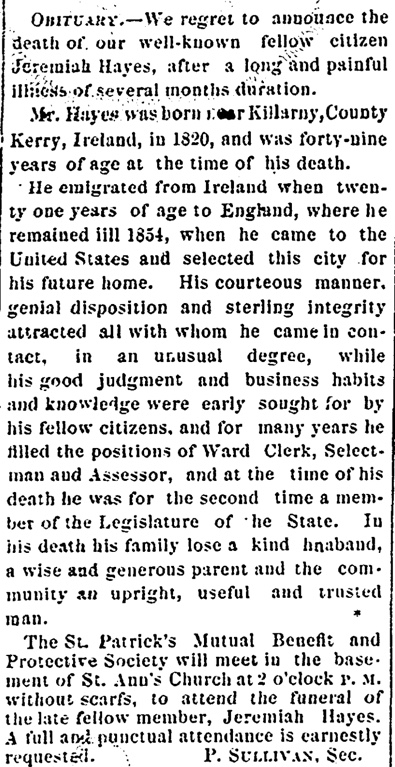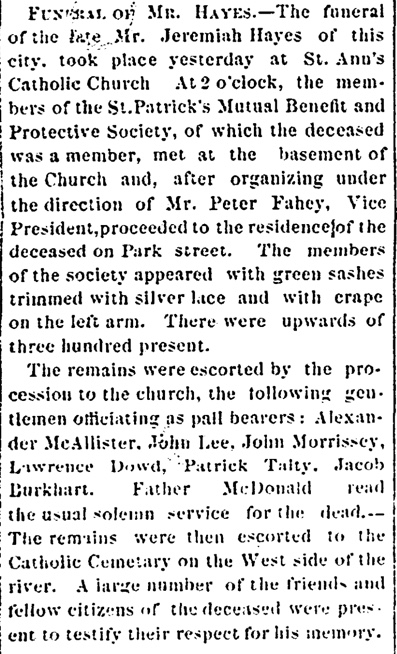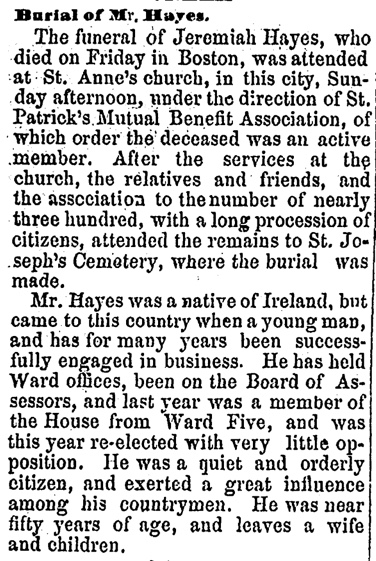One of the joys of family history research is uncovering the hidden stories of our ancestors. For years, Jeremiah Hayes was little more than an elusive name in our family tree – a mystery waiting to be solved. With patience and persistence, we pieced together his journey from Ireland to America, and in doing so discovered a tale of resilience, community, and legacy that still resonates today.
Early Life in County Kerry, Ireland (1820)
Jeremiah Hayes was born in 1820 near the lakes of Killarney, County Kerry, Ireland. Growing up in the 1820s and 1830s in rural Ireland, he would have experienced a humble upbringing amid Ireland’s beautiful yet challenging landscape. In his early adulthood, Ireland was on the brink of great upheaval – just a few years before the Great Famine. Perhaps driven by the search for opportunity, Jeremiah made a bold move at age 21: he emigrated from Ireland to England around 1841. This young Kerryman left home to seek work and a better life across the Irish Sea.
A New Life and Family in England
In England, Jeremiah settled in London during the 1840s, a time when the city’s Irish community was growing. It was there that he met Catherine “Margaret” Ahern, an Irishwoman who would become his wife. They married in London in 1849, planting new roots far from home. The young couple soon started a family of their own. During their years in England, Catherine (Margaret) gave birth to two sons, John J. Hayes and William M. Hayes, who would carry the family name forward. Life in London’s bustling East End (the 1851 census later places them in Shadwell, Middlesex) was undoubtedly a big change from rural Ireland. Yet Jeremiah adapted, honing the skills and work ethic that would define him. By the early 1850s, however, the promise of an even brighter future across the Atlantic beckoned.
Emigration to America and Settling in New Hampshire (1854)
In 1854, at about age 34, Jeremiah Hayes bravely immigrated with his young family to the United States, part of a larger wave of Irish leaving Europe. He selected Manchester, New Hampshire as his new home, arriving at a time when Manchester was a booming mill town hungry for labor and entrepreneurship. The city’s growing Irish-American community and the presence of established Catholic parishes made it a welcoming place for immigrant families.
Jeremiah wasted no time building a life in Manchester. He set up a small grocery business, becoming a grocer by trade – an occupation that put him at the heart of the community. His shop likely served fellow immigrants and townsfolk with daily necessities, and through it he became a familiar, friendly face in the city. Manchester’s directories soon listed his name, and by 1858 the Hayes family was well established on Manchester’s West Side. Jeremiah and Catherine’s home on Park Street bustled with their children (eventually more than just John and William), and the family became active members of the local St. Anne’s Parish. Far from the green hills of Killarney, Jeremiah had created a new haven for his family in the Queen City of New Hampshire.
Community Service and Public Life
Hard work and integrity brought Jeremiah not just business success but also public trust. Described by those who knew him as a man of “courteous manner, genial disposition and sterling integrity,” he quickly earned the respect of his neighbors. It wasn’t long before his fellow citizens sought his knowledge and good judgment in public matters. Jeremiah answered the call of civic duty and over the years served in several local government roles. He was elected as a Ward Clerk for his district and later as a Selectman, helping administer city affairs. His acumen in financial matters led to an appointment as a city Assessor, where he oversaw property assessments and municipal budgets. In each role, Jeremiah was known for being upright, useful and trusted – a dependable public servant who truly cared about his community.
His dedication culminated in service at the state level. In 1868, representing Manchester’s Ward 5, Jeremiah took a seat in the New Hampshire House of Representatives. He served capably as a legislator and earned the confidence of voters, being re-elected for a second term in 1869. At the time of his death, he was serving his second term in the State Legislature – a remarkable achievement for an Irish immigrant of that era. Throughout his public life, Jeremiah remained humble and approachable. Friends and colleagues recalled that he never lost his warm geniality despite the responsibilities he carried. He was active as well in the Irish-American civic sphere, notably as a member of the St. Patrick’s Mutual Benefit and Protective Association – a fraternal benefit society that fostered community and charity among Manchester’s Irish families.
Excerpt from the Manchester Weekly Union obituary of Jeremiah Hayes (May 11, 1869). It highlights his journey from Ireland, his “genial disposition” and integrity, and years of service as Ward clerk, Selectman, Assessor, and state legislator.
By all accounts, Jeremiah Hayes was deeply woven into the fabric of Manchester life. The local newspaper praised him as “an upright, useful and trusted man” whose family lost “a kind husband and generous parent,” and whose community lost a valued citizen. He had come a long way from Killarney, making his mark through hard work, friendliness, and public spirit. Little wonder that when misfortune struck, the community would feel his loss profoundly.
A Tragic Final Chapter
 In the late 1860s, after years of industrious living, Jeremiah’s health began to falter. The strain of business and public service – and perhaps a lifelong habit of taking solace in drink – took a grave toll. By early 1869 he was seriously ill and stepped back from daily affairs. He endured “a long and painful illness of several months’ duration,” as one obituary noted. Hoping for recovery, Jeremiah went to Boston, possibly seeking advanced medical care or support from extended family. Sadly, he passed away in Boston on May 7, 1869, at just 49 years old.
In the late 1860s, after years of industrious living, Jeremiah’s health began to falter. The strain of business and public service – and perhaps a lifelong habit of taking solace in drink – took a grave toll. By early 1869 he was seriously ill and stepped back from daily affairs. He endured “a long and painful illness of several months’ duration,” as one obituary noted. Hoping for recovery, Jeremiah went to Boston, possibly seeking advanced medical care or support from extended family. Sadly, he passed away in Boston on May 7, 1869, at just 49 years old.
Jeremiah’s cause of death was recorded starkly in the Massachusetts vital records: “cirrhosis of the liver” due to “general drunkenness.” In today’s terms, he succumbed to alcoholic liver disease. The language of the 1869 death register may be blunt, but it reflects the reality that Jeremiah struggled with alcohol in his final years. There is no sugar-coating this part of his story – a sobering reminder that our ancestors were fallibly human. The genial grocer and public servant who had given so much to his community was ultimately overcome by an illness he could not defeat.
Back in Manchester, the first hint of Jeremiah’s fate was his sudden absence from city life. Researchers later noted that his name disappeared from Manchester directories after 1868, a clue that something was amiss. News soon reached home of his death down in Boston. For his family and friends, it must have been a devastating revelation. Yet, their response to his passing showed just how beloved he was in Manchester.
A Funeral Attended by Hundreds
 Jeremiah Hayes’s funeral became one of the largest shows of respect the Manchester Irish community had seen. On Sunday, May 9, 1869, two days after his death, mourners gathered to honor him. The solemn funeral Mass was held at St. Anne’s Catholic Church (then the heart of the West Side Irish parish) at 2 o’clock in the afternoon. In a remarkable tribute, over 300 members of the St. Patrick’s Mutual Benefit Association – the Irish benevolent society to which Jeremiah belonged – turned out in full force to pay their respects. They met at the church’s basement hall, organizing themselves under the direction of the society’s officers before proceeding to the Hayes family residence on Park Street. The members marched wearing green sashes trimmed with silver lace, with black crape armbands as a sign of mourning. This dignified procession of hundreds then escorted Jeremiah’s remains to the church, in what must have been a moving sight.
Jeremiah Hayes’s funeral became one of the largest shows of respect the Manchester Irish community had seen. On Sunday, May 9, 1869, two days after his death, mourners gathered to honor him. The solemn funeral Mass was held at St. Anne’s Catholic Church (then the heart of the West Side Irish parish) at 2 o’clock in the afternoon. In a remarkable tribute, over 300 members of the St. Patrick’s Mutual Benefit Association – the Irish benevolent society to which Jeremiah belonged – turned out in full force to pay their respects. They met at the church’s basement hall, organizing themselves under the direction of the society’s officers before proceeding to the Hayes family residence on Park Street. The members marched wearing green sashes trimmed with silver lace, with black crape armbands as a sign of mourning. This dignified procession of hundreds then escorted Jeremiah’s remains to the church, in what must have been a moving sight.
Newspaper account of Jeremiah Hayes’s funeral in Manchester. Over “three hundred” members of St. Patrick’s Mutual Benefit Association attended in a procession wearing green sashes of the order. The service at St. Anne’s Church was followed by burial in St. Joseph’s Cemetery.
 Inside St. Anne’s, Father McDonald led the congregation in the solemn requiem service, offering final prayers for Jeremiah’s soul. Six pallbearers – community members and friends – bore the coffin, a testament to the esteem of those chosen to carry him. After the church service, a long procession of family, friends, fellow officials, and members of the association accompanied the hearse across the bridge to the Catholic cemetery on the west side of the Merrimack River. There, at St. Joseph’s Cemetery, Jeremiah Hayes was laid to rest in hallowed ground. His widow Catherine and their children, dressed in mourning black, would have stood by as final rites were performed at the gravesite. The newspaper reported that “a large number of friends and fellow citizens…were present to testify their respect for his memory,” underscoring how widely he was admired.
Inside St. Anne’s, Father McDonald led the congregation in the solemn requiem service, offering final prayers for Jeremiah’s soul. Six pallbearers – community members and friends – bore the coffin, a testament to the esteem of those chosen to carry him. After the church service, a long procession of family, friends, fellow officials, and members of the association accompanied the hearse across the bridge to the Catholic cemetery on the west side of the Merrimack River. There, at St. Joseph’s Cemetery, Jeremiah Hayes was laid to rest in hallowed ground. His widow Catherine and their children, dressed in mourning black, would have stood by as final rites were performed at the gravesite. The newspaper reported that “a large number of friends and fellow citizens…were present to testify their respect for his memory,” underscoring how widely he was admired.
That May afternoon, the streets of Manchester witnessed an extraordinary outpouring of grief and gratitude. The very community that Jeremiah had served and befriended came out en masse to bid him farewell. It was a funeral not just for a man, but for a local hero in the eyes of many – an immigrant who had achieved the American dream of respectability, only to be struck down too soon. The echoes of the marching mourners, and the sight of hundreds united in tribute, surely left an impression on the city for years to come.
Genealogical Journey: Rediscovering Jeremiah’s Story
For generations, the details of Jeremiah Hayes’s life and death faded from family memory. His wife Catherine and their children carried on in Manchester after 1869, and the Hayes family line endured through son John and others. But as years passed, only fragments of Jeremiah’s story were handed down – a birth in Ireland, a vague notion of an early death, and little more. As a descendant of Jeremiah, I grew up knowing hardly anything about this great-great-grandfather. The specifics of when, where, and how he died were a puzzle that long went unsolved. Family members had searched New Hampshire records in vain; Jeremiah simply vanished from the local documents after 1868. For a time, we wondered if he’d left town or if some records were lost.
The breakthrough came when we extended our search beyond New Hampshire. Years of persistence finally led us to an unexpected place – historic newspaper archives. In an old issue of the Manchester Weekly Union from May 1869, we found the poignant obituary that revealed so much: Jeremiah had died in Boston after months of illness. We learned of his exact age (49) and his Irish hometown (near Killarney) from that clipping. More digging unearthed two more invaluable notices: a detailed funeral account in the local news, and a burial notice that summarized his community contributions and the massive turnout at his funeral. Piece by piece, the mystery of Jeremiah’s final chapter was solved. The Massachusetts death certificate confirmed the cause of death as cirrhosis due to alcoholism, a fact that, while saddening, brought truth to light.
Reading those old newspaper columns for the first time was an emotional experience. In the obituary’s flowery Victorian prose, I could sense the esteem and affection people had for Jeremiah. The funeral report allowed me to visualize the grand procession of our ancestor’s send-off – the green sashes of the Irish society, the throng of 300 mourners winding through city streets to St. Joseph’s Cemetery. It struck me how well-loved and respected he must have been, despite the private struggle that ended his life. For a researcher who had hit one brick wall after another, these discoveries felt like opening a time capsule. After 150+ years, Jeremiah’s story was coming alive again.
The lesson I learned is one I now share with every family historian: persistence pays off. It took patience and creative sleuthing to find these records, but the payoff was immense. We not only uncovered the facts of Jeremiah Hayes’s life and death – we also reclaimed his legacy from obscurity. What started as a quest for a death date became a richer understanding of an ancestor’s character, accomplishments, and the community that rallied around him.
Reflections on Resilience and Legacy
The life of Jeremiah Hayes, though cut short, is a testament to resilience and the enduring legacy of family. He journeyed across oceans and nations to build a better life, rising from an immigrant laborer to a community leader. He weathered personal challenges and setbacks – from starting over in a new land to battling the demons of ill health – yet he left an indelible positive mark on those around him. His story reminds us that even our forebears had their flaws and struggles. Jeremiah was not a perfect man, but he was a good man who worked hard, loved his family, and served his neighbors.
In the wake of his tragic death, it was the strength of his family that carried forward. Catherine, his widow, persevered in raising their children at a time when support for single mothers was scarce. His children – including John and William – grew up and had families of their own, ensuring that Jeremiah’s bloodline survived and thrived. Today, more than a century and a half later, we – his descendants – are the living proof of that survival. We carry in us the legacy of a brave Kerry-born man who crossed the world, built community, stumbled at times, but ultimately contributed something meaningful to the tapestry of American life.
In remembering Jeremiah Hayes, we honor not just one ancestor’s journey, but also the resilience of a family that endured beyond grief. His story, once lost to time, now lives on as part of our family narrative – a source of pride, lessons learned (even from the hard truths), and inspiration. Persistence in research allowed us to illuminate Jeremiah’s life, and in doing so, we gained a deeper appreciation for the strength and character that runs in our family. Our family history is richer for knowing him. Jeremiah’s legacy is safe in our memories now, a reminder that the trials and triumphs of those who came before us continue to shape who we are today.




